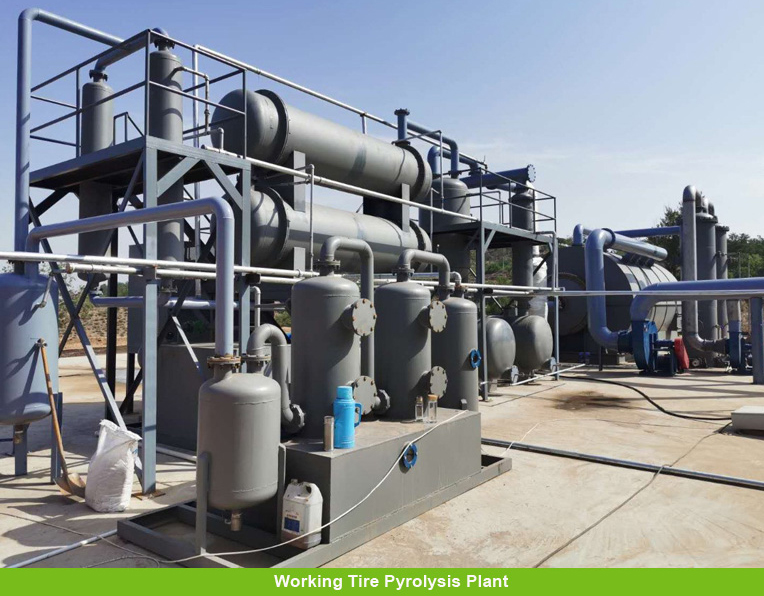Tire Recycling Process Description


1. Waste tires are placed into the pyrolysis reactor. The tires must be dry of moisture to avoid the creation of steam vapor before the reactor reaches 100 degrees. This could possibly affect the purity of the collected oil and gas. When the reactor temperature reaches 280 degrees, the tires begin to crack, or breakdown, and the oil and gas production begins. The operating temperatures are best between 280 and 320 degrees.
2. The oil and gas produced by the tire pyrolysis process flow through the catalytic chambers slowly, which allow them to fully breakdown. The oil and gas in the catalytic chamber flow from bottom to top allowing heavy oil to settle at the bottom after touching the walls of the chamber. This improves the purity of the oil and gas. When the pyrolysis process is complete, the oil and residues at the bottom of catalytic chamber are cleared.
3. The oil and gas flow through the first vertical condenser and are stored in the oil tank after cooling. There is a large amount of oil and gas, and the vertical condenser will produce natural negative pressure, which will reduce back pressure on the reactor to avoid blocking or clogging. After that, partially uncooled oil and gas are further separated from the oil and gas by a separator unit. The remaining oil and gas are passed through the second condenser and then a third condenser, to ensure that the oil and gases are fully cooled, and the oil yield is the largest. The second condenser is a horizontal condenser with a cooling surface larger than the vertical condensers.
4. After passing through the three condensers, the oil and gas are completely condensed. Any residuals are a non-condensable gas. The water seal is one of the most important safety devices. It prevents tempering, but also can act as a monitor of the cooling system. If cooling is not complete, oil will be present in the water seal device.
5. The tail gases produced by the tire pyrolysis process plant are recycled back into the process to heat the reactor. The plant is also equipped with an odor removal tank and system, so the exhaust is odorless and pollution-free.
6. After the tire pyrolysis process ends, the carbon black is automatically discharged from the side of the reactor and the steel residue is removed from the bottom of the reactor.
Our tire pyrolysis process plant completely evaporates out all the oil and gas contained in the raw materials. The three condenser design can guarantee that pyrolysis oil can be cooled thoroughly. Therefore, with the same raw material, our tire pyrolysis process plant yields more oil than other tire pyrolysis processes.
The final products of the pyrolysis process are 40%-50% crude oil, 30% carbon Black, 15% waste steel wire, and 10% combustible gas.
2. The oil and gas produced by the tire pyrolysis process flow through the catalytic chambers slowly, which allow them to fully breakdown. The oil and gas in the catalytic chamber flow from bottom to top allowing heavy oil to settle at the bottom after touching the walls of the chamber. This improves the purity of the oil and gas. When the pyrolysis process is complete, the oil and residues at the bottom of catalytic chamber are cleared.
3. The oil and gas flow through the first vertical condenser and are stored in the oil tank after cooling. There is a large amount of oil and gas, and the vertical condenser will produce natural negative pressure, which will reduce back pressure on the reactor to avoid blocking or clogging. After that, partially uncooled oil and gas are further separated from the oil and gas by a separator unit. The remaining oil and gas are passed through the second condenser and then a third condenser, to ensure that the oil and gases are fully cooled, and the oil yield is the largest. The second condenser is a horizontal condenser with a cooling surface larger than the vertical condensers.
4. After passing through the three condensers, the oil and gas are completely condensed. Any residuals are a non-condensable gas. The water seal is one of the most important safety devices. It prevents tempering, but also can act as a monitor of the cooling system. If cooling is not complete, oil will be present in the water seal device.
5. The tail gases produced by the tire pyrolysis process plant are recycled back into the process to heat the reactor. The plant is also equipped with an odor removal tank and system, so the exhaust is odorless and pollution-free.
6. After the tire pyrolysis process ends, the carbon black is automatically discharged from the side of the reactor and the steel residue is removed from the bottom of the reactor.
Our tire pyrolysis process plant completely evaporates out all the oil and gas contained in the raw materials. The three condenser design can guarantee that pyrolysis oil can be cooled thoroughly. Therefore, with the same raw material, our tire pyrolysis process plant yields more oil than other tire pyrolysis processes.
The final products of the pyrolysis process are 40%-50% crude oil, 30% carbon Black, 15% waste steel wire, and 10% combustible gas.
